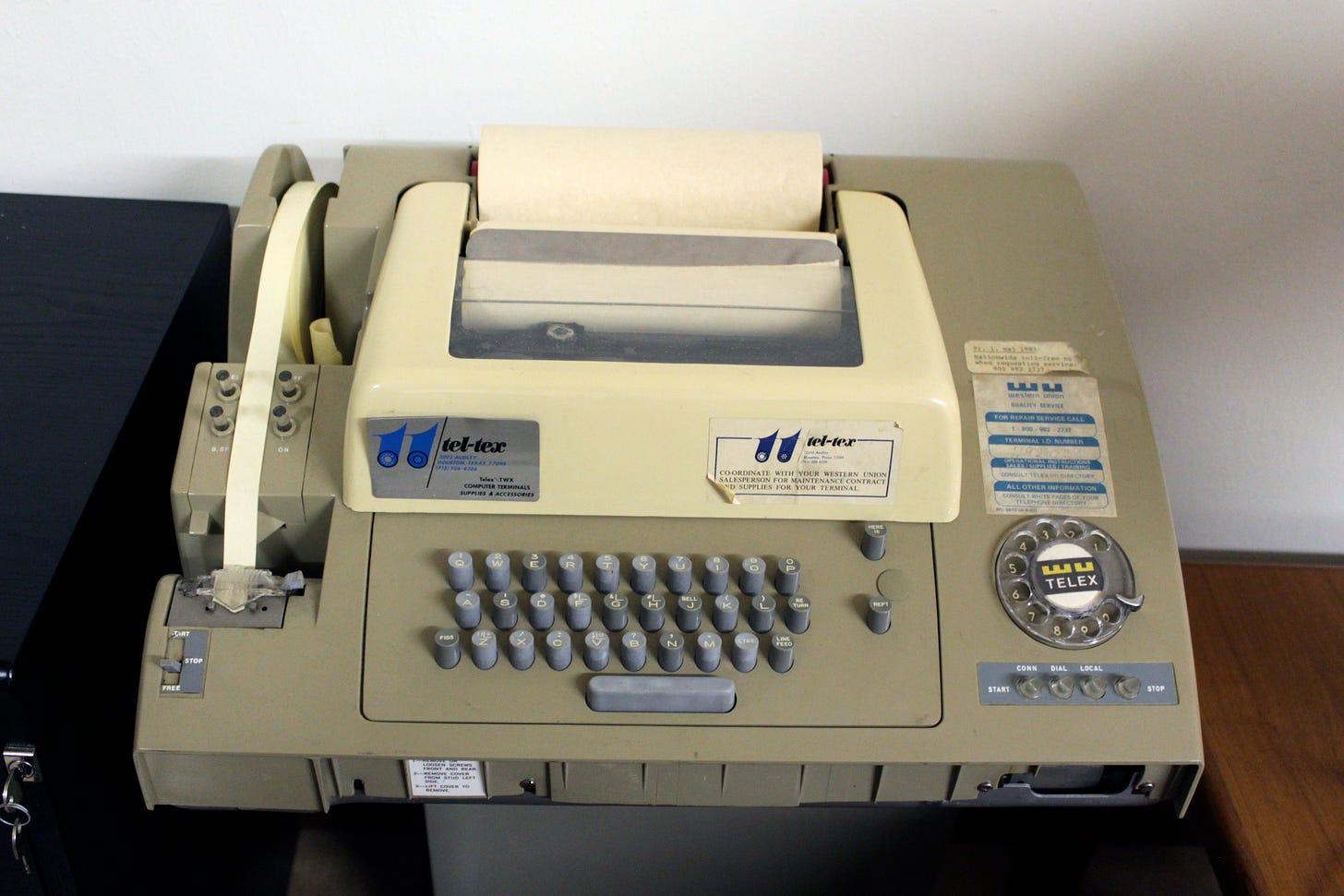Standardization & Globalization
SWIFT was an answer to American hegemony in international finance and ushered in a new era of international finance in 1973. What lessons could we learn for implementing new standards and rails?
Welcome back everyone! Thank you to everyone who’s stuck around, subscribed in my hiatus, and hello to the newest 8 subscribers! Thanks for your support! If you want to join them, consider subscribing.
Some of the topics we’ll cover include:
What’s needed for international payments
Why was SWIFT created?
The implications of Standards on international payments
Possible post-SWIFT futures (SWIFT GPI, cross-border RTP, blockchain, CIPS)
Let’s first explain the building blocks of modern international payment systems — trust, standardization, network, and nostro/vostro accounting.
Trust: The history of commerce is, at its core, the history of trust building. You won’t provide goods/services if you don’t trust the other party to compensate you.
Standardization: Standards help to engender trust — 1 kg = 1 kg whether you’re in Cairo, Mumbai or Mexico City — and reduce frictions which encourages greater use.
Common Network: Trust and Standardization are great, but if they aren’t able to work with others, then there’s little value in international uses.
Nostro/Vostro Accounting: Renaissance Italian merchants needed a way to track account balances between different branches and in different currencies and if it ain’t (too) broke, don’t fix it. By keeping a double ledger of “ours” and “yours” account balances, bankers could easily manage international currency exchanges.
Why SWIFT was needed
Thank you to Susan V. Scott & Markos Zachariadis for compiling this SWIFT textbook and to my colleague Therese who greatly improved this section.
Globalization sends trade parabolic
Global trade exploded in the 1950s and 60s (see chart below) as the world became more connected, trade reopened following the end of WWII, and post-war production was put to peacetime ends. Conducting trade meant navigating a complex web of international trade agreements, regulations, and protectionism.
The network of Correspondent Banks applies some brakes
Increased international trade meant more funds needed to be moved from one currency to another, but rather than set up a bank branch in each jurisdiction, banks relied on a network of Correspondent Banks — a bank which provides services to another bank. In the case of cross-border transactions this included the use of Nostro/Vostro accounts mentioned above.
Correspondent banks allowed for a bank in the U.S. to complete transactions with banks in China, England, Germany, and Brazil without the need to set up a branch in each country. It worked fine enough…except sending transactions could require stops at dozens of banks which (2) was expensive and (b) introduced a lot of room for costly errors.
High Tech Messaging, and High-Touch Security
The Telex machine, developed in the 1920s, was a revolution in electronic communication. It served to convert text into telephone signals which could then be transmitted via wires (thus the name) and converted back into text on the other end.
Now, messages could be delivered in seconds instead of minutes or days via courier or telegraph…but messages could only move at 8 bytes or one character per second.
o
n
e
Compounding the speed of transmission were t additional issues:
Security, requiring manually solving a math problem to test if a transaction had been tampered with while traveling along public transmission lines
free-form data entry meant that keying errors and differences between banks required intense amounts of rework and clarification
To quote Scott & Zachariadis: “[there was] no critical mass to share existing practices, define common standards, develop interfaces, adopt security protocols, and adapt their back-office systems.” That critical mass would come when 239 banks from 15 countries joined together in 1973 to create and adopt a common set of messaging standards.
SWIFT to the rescue
The Society for Worldwide Interbank Financial Telecommunication, SWIFT, is a Belgian cooperative society providing services related to the execution of financial transactions and payments between banks worldwide. SWIFT was successful because of its ability to solve for…
Standards: The first standards, SWIFT-1, went live in 1977 after four years of broad collaboration and intense focus two goals: replacing telex and enabling the end-to-end automated processing of international transactions.
Security: SWIFT processes transactions through its own proprietary network and takes on the information security risks for transaction messaging.
Speed: Initially capable of transmitting a whopping 4.8 to 9.0 kbps or around 1,100 characters per second, SWIFT-1 was a gigantic leap forward in messaging speed.
Thanks to the security (plus incumbency bias and network effects) and collaboration SWIFT has become “the only game in town” and continues to remain the dominant player in international payments: transmitting more than 42 million transactions per day in 2021.
What comes next?
New payment methods and file types have continued to be developed since 1977 and SWIFT has managed to adapt them each time. The newest file format standard, ISO 20022 — international standard for faster payments file formatting, is being adopted in November 2022. But that doesn’t mean that SWIFT is not without challengers:
CIPS, Cross-Border Interbank Payment System, is China’s answer to SWIFT has around 1/10th the number of member banks (1,100 vs. 11,000) but has garnered renewed media attention given Russian banks being ousted from SWIFT earlier this year.
Real-time payments like RTP in U.S., Zengin in Japan, UPI in India, and Pix in Brazil all utilize ISO 20022, which has the potential to allow easier cross-border payments. The need for a centralization and secure transmission lines, however, limit this at the moment
“Bitcoin fixes this.” Distributed ledger technologies have the potential to remove the need for SWIFT or any centralized clearing group, but you’d have to solve for security (hacks happen), stability (re: volatile prices), and secrecy (open ledgers mean anyone can see everyone’s transactions)
SWIFT introduced its Global Payments Innovation, gpi, initiative in 2017 to solve three common short-falls of traditional SWIFT:
End-to-end payment tracking: no more “black box.” Now sending and receiving banks can know exactly how a transaction is being routed.
Transparency of fees: cross-border transactions are expensive partly because of their opacity. Disclosing fees at each stop for the payment will make it more difficult to people to do
Confirmation of credit: A long-time issue was wondering whether funds had been successfully deposited into the recipient's account. gpi solves for this through end-to-end tracking.
For any contender to overcome SWIFT’s almost insurmountable first-mover advantage, it will have to solve for Standards, Security, and Speed such that switching to the new network is worth the costs AND get enough participants for network effects to really take hold. So, for now, SWIFT is here to stay.
Further Reading/Listening:
“The Field Guide to Global Payments” by Sophia Goldberg (2022)
"Selected Electronic Funds Transfer Issues: Privacy, Security, and Equity" by J. H. Gibbons (1982)
“The Origin of the Bill of Exchange” by AP Usher (1914)
Some personal notes for those of you who made it this far:
Our daughter can crawl — Being a parent is hard and isn’t for everyone, but it’s certainly the most rewarding thing in my life.
I recently sat for the CFA Level 3 exam — The first one plus this meant little time for reading anything that wasn’t exam prep.
I changed jobs — Hello to all my Truist and Flywire readers, let’s grab coffee!
My DMs on Twitter @WilsonHarmond and email are always open! I’m working on getting back into my writing groove, so please give me feedback on where I can improve or what you’d like to hear about!
If you liked it, let me know in the comments or share with your friends!






